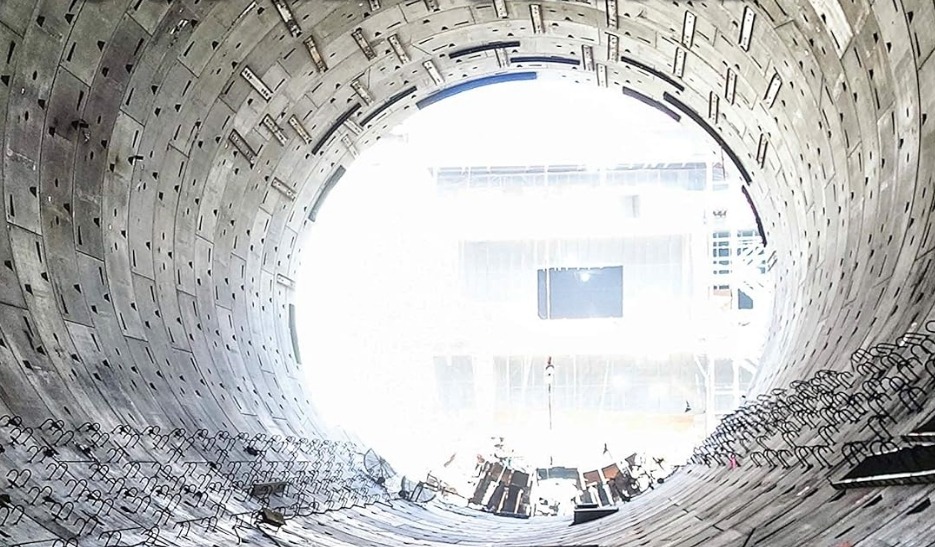How long would Seattle have to wait for a really good book-length history of the monumental State Route 99 Viaduct replacement tunnel – the longest and widest road tunnel in the contiguous United States

To date, we’ve had a marvelous photographic retrospective, Catherine Bassetti’s Supertunnel, Journey from Light to Light (2021).
But until now, no straight-up history of the project. This week it finally arrived. From a most unexpected source: the perfect team of children’s book author Amanda Abler and illustrator Katy Wu. You can find it in the children’s section: Big Bertha: How a Massive Tunnel Boring Machine Dug a Highway Under Seattle, Little Bigfoot (September 17, 2024)

The book tells the story of the tunnel from the perspective of one of the project’s civil engineers, Greg Hauser. Perhaps you have never heard of him. But he is well known within the largely invisible community of people who work unseen and unknown to create the amazing world of our underground infrastructure. He was in fact, one can truly say, deep into the SR 99 tunnel, just as the book depicts. Before that –among other projects from one end of the country to the other – he was deep into construction of the very challenging tunnels carrying wastewater to and from the Brightwater Treatment Plant in Snohomish County.
Katy Hu’s drawings of Hauser capture the man, mustache and all. Her drawings of the boring machine and the tunnel are also remarkably good renderings, right down to the configuration of the control panel in the boring machine operator’s cab. Don’t be fooled into thinking this is just a book for children. Writer Amanda Abler charts a marvelous and blessedly succinct through line, remarkably faithful to real events, from the day this project began (the same day as the Nisqually Earthquake in 2001). Six pages of technical detail that follow the story are an excellent window for lay people of any age to appreciate some of the most interesting facets of this project.
These are all reasons why this book stands tall. But there is another. This is the kind of book that needs writing on anything and everything called a megaproject. It is not machines that build megaprojects, not even big and astonishing machines like Bertha, not even the big and astonishing megaprojects like the SR 99 tunnel.
It is people who build megaprojects. Greg Hauser would never say that he built the SR 99 tunnel, even if he must be delighted that his Boswell in the persons of Amanda Abler and Katy Wu have pulled him out from under his hard hat. Greg Hauser would say, “We all built the SR 99 tunnel and I’m proud to have helped.” That is why this book renders such a service in what amounts to its epilogue:
“This enormous project was the result of hundreds of people working and coordinating together. Different types of engineers in Japan and the United States, electricians, laborers, that performed a variety of trades, teamsters that drove trucks and buses, administrators, inspectors and many unseen people joined together to give this beautiful tunnel to the people of Seattle.”
Who cannot like this book’s opening epigraph, in verse:
Slowly and surely
beneath the city
sandy, silty
grimy, gritty.
her cutterhead grinds
motor whines
shields keep clear
the churning gears
as she forges a path
shows what can be done
when so many parts
work together as one.
Everyone who worked on the project knows what an adventure it was to get all those many parts, and not just on the machine, to work together.
There will surely be more histories, undoubtedly longer, to come of the SR 99 tunnel. Their worth as history will entirely be judged by their fidelity to recounting the incredible diversity, capacity and tenacity of the people who built the project. The boring machine Bertha was their often-unwieldy tool: very big, and every bit as cranky and troublesome as it was big. Thanks, then, to the people: Greg Hauser and all the many more who got the job done. It was they, not Bertha, who put Seattle on the map as a builder of truly world-class public works projects.
Discover more from Post Alley
Subscribe to get the latest posts sent to your email.

Wonderful engineering, for sure. No argument about the majesty of the achievement.
But imagine if we as a city had spent the same amount of money making it easier for people to get in/out/through downtown instead of just moving cars under it. The tunnel is a monument to car culture and our collective lack of creativity.
Horsepucky. I was for renovating the AWV (and actively campaigned against the tunnel since this was first proposed in the 1990’s during the round that resulted in the SR-16 toll bridge), but given a choice between the tunnel we got and trying to use surface streets the tunnel was the only rational choice.
Hoping people won’t drive is not a plan, and Downtown is already enough of a cluster**** as it is.
I completely disagree with that expat.
You haven’t even walked through the new Waterfront park etc etc etc yet.
No one has.
Biased much?
…not to mention the thousands that could have died during a big quake and the billions of dollars of damage.
One can hear bids and walk in the sun, admiring the new flora, take a side trip to touch the actual waterfront water,
Doug: Magnificent review! Thanks.
“The Wilbs”…
Gotta love him…